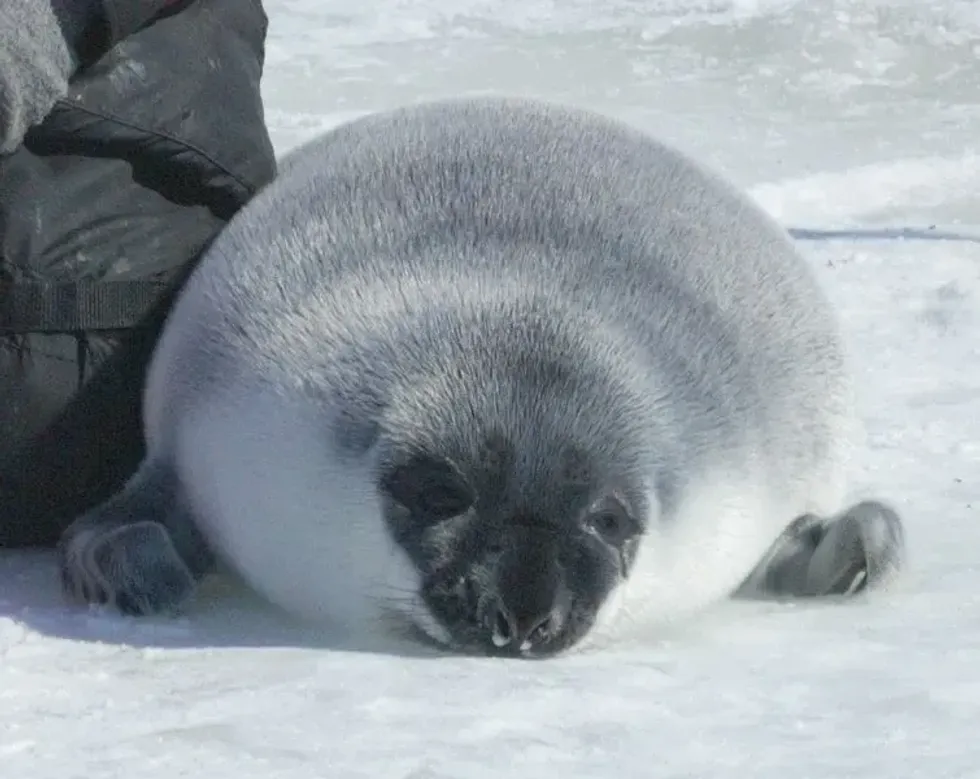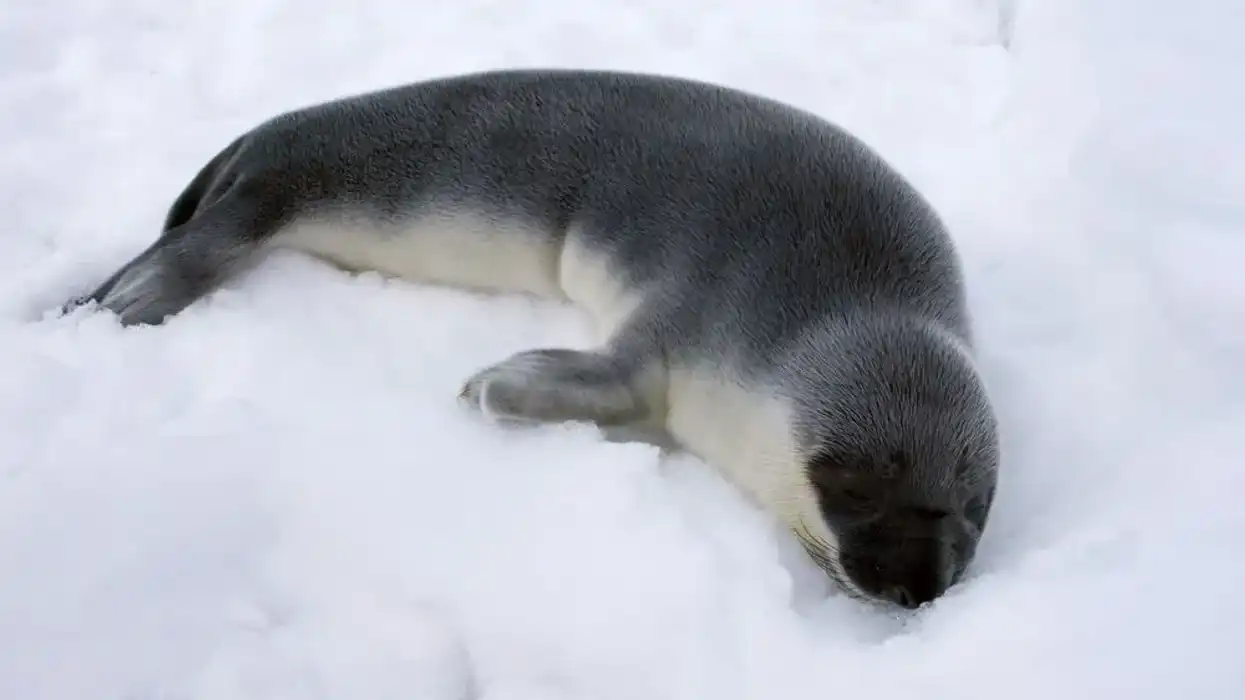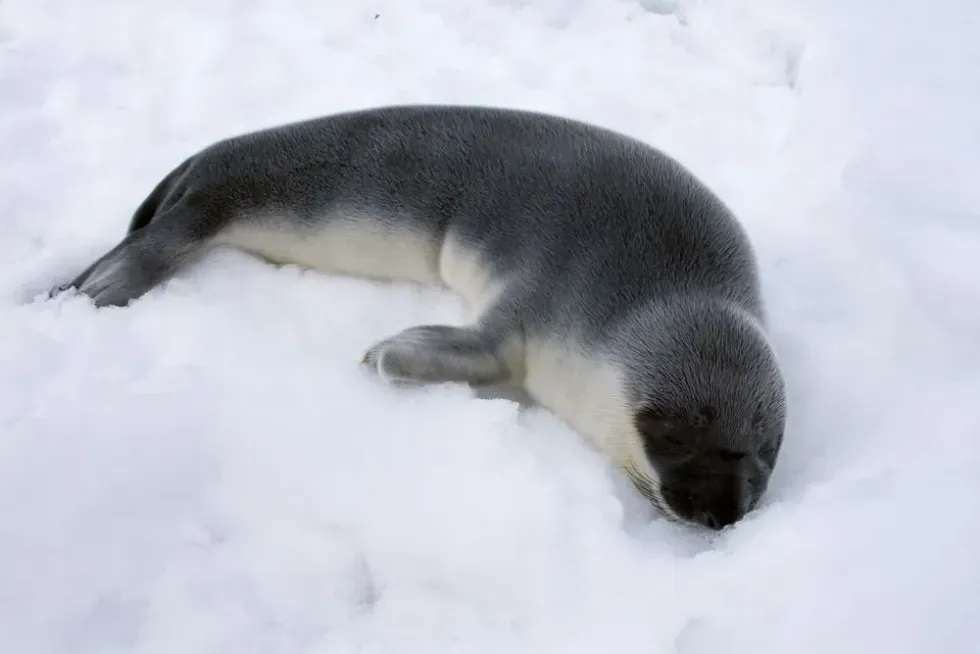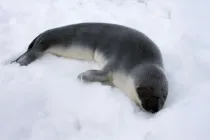Fun Hooded Seal Facts For Kids

The hooded seal (Cystophora cristata) belongs to the family of Phocidae, they are silver-gray in color with black spots on their entire body and black face.
The unique feature that only a male hooded seal has is its elastic nasal forming a hood that can be inflated, giving them the appearance of a pinkish-red balloon, and when they have relaxed their nasal looks like a wrinkled sac in front of their nose.
The adult male inflates its nasal sac to attract females during the mating season These species are found along the coastal region of North America to the north of Maine.
Though they are a large-sized species, these species are extremely agile and athletic in open water. Hooded seals are visual predators with no external ear flaps, though they have excellent hearing ability helping them underwater while diving deep.
Hooded seals throughout the years have seen a huge population decline due to unchecked hunting for their meat and fur in trade and domestic use, and now with a strict conservation effort towards their safety, hopefully in the near future, they can get back to their old population and once again become an integral part of the ocean waters and land ecosystem.
Many tourists feel like they can have fun swimming with seals. Experts, however, mention that swimming with seals is not safe. Seals are territorial and they can get aggressive if humans enter their territory.
If you liked these true facts about the hooded seal, then you'll surely like these facts about the seal and harbor seal too!
Hooded Seal Interesting Facts
What type of animal is a hooded seal?
Hooded seals (Cystophora Cristata) are also known as bladder bearer seals, these animals are large-sized mammals and have a silvery-gray coat with dark spots all over their body, and are found in the open waters of the Arctic Ocean and North Atlantic Ocean.
Hooded seals range from the Gulf of St. Lawrence to the Davis Strait and the Barents Sea.
Like other pinnipeds, the hooded seals have extremely sensitive whiskers that help them to detect prey while foraging for food.
What class of animal does a hooded seal belong to?
The hooded seal belongs to the mammal class of animals. Having mammary glands to feed their young ones, the presence of the three ear bones, fur or hair, and the neocortex (region of the brain) are what qualifies the hooded seals as mammals.
How many hooded seals are there in the world?
Currently, the hooded seal population is over 650,000 in the world, out of which 250,000 are found near the Jan Mayen Island and the rest 400,000 in the northwest Atlantic Ocean.
Where does a hooded seal live?
Hooded seals (Cystophora cristata) range from the Eastern coast of North America to the North of Maine. This species is also found in some places in Europe and the coast of Norway. Hooded seals are seen gathering around Bear Island, Iceland, northern Greenland, Norway, Canary Islands, and occasionally in Siberia.
What is a hooded seal's habitat?
Hooded seals can be found in the Coastal areas of the North Atlantic and Arctic Oceans, these species are excellent divers spending most of their time inside the water. Hooded seals can dive up to 3280.8 ft (1000 m) deep and they can hold their breath for 15-20 min foraging for food.
These marine mammals are found near the ice cover when they are on land and migrate annually to stay within the range of drifting pack ice.
Who do hooded seals live with?
Hooded seals are non-social marine mammals. This species prefers to live a solitary life, coming together during breeding season, opting to remain alone for the most part of the year. Hooded seals are extremely aggressive and territorial in nature and will defend their territory from other seals.
How long does a hooded seal live?
Hooded seals can live up to 35 years on average, male hooded seals are larger in size but have a shorter lifespan. Captive hooded seals do not survive due to diseases such as cranial infections and tuberculosis.
How do they reproduce?
Female hooded seals reach their sexual maturity at the age of three years old and give birth to their first young pups at the age of five years, while males mature a year later. Hooded seals start their annual migration once they reach sexual maturity and reach breeding grounds in the spring season for two to three weeks.
During this period, males will remain closer to the females in the breeding area to get the mating rights while the adult females give birth and nurse their pups.
Hooded seals are aggressive and territorial creatures and they are seen pushing and threatening each other with their inflated nasal sac while protecting their breeding grounds. Mating usually occurs underwater from the months of April to June.
The gestation period for hooded seals is 240-250 days, young pups are precocial and are able to move and swim on their own. Adult males do not participate in raising the young pups as they live a solitary life and come together only during the breeding season.
What is their conservation status?
As per the IUCN list, hooded seals are listed as Vulnerable species, in the 18th century, these species were hunted for their fur and oil. The popularity of their blueback pelts was the major reason for the decline of their population.
In spite of the treaties and agreements for banning seal hunting in areas such as the Gulf of St. Lawrence and Davis strait, their population is still on the decline for unknown reasons.
Hooded Seal Fun Facts
What do hooded seals look like?
Hooded seals have silvery-gray color fur with black spots all over their body and a black color head. Male hooded seals have a stretchy nasal cavity (hood) in their nose, with two sections that can be inflated and stretched across their face looking like a pinkish-red balloon.
A mature male hooded seal uses this inflated nasal cavity to attract the attention of females and to show aggression towards other hooded seals.
Hooded seal pups are blue-gray in color fur with white bellies making them target for hunting for the pelt, these seal species are mostly hunted for their pelts.

How cute are they?
Hooded seals are large-sized mammals but a newly born pup is the cutest creature with blue-gray fur and flopping around with their oversized flippers on the ice after birth.
How do they communicate?
Hooded seals communicate with each other through various vocal sounds. Hooded seals can hear from the top of the fast ice if the sound is coming from the water as well, transmitting the sound waves through the ice.
Hooded seals are sometimes found vocalizing in the form of a song with repetitive sequences varying slightly with time. Female hooded seals use vocalization to communicate with the seal pups to alert, discipline their behavior or call them.
How big is a hooded seal?
Hooded seals are large-sized animals, adult males in comparison to adult females are larger and these seals will grow up to 6.8-8.6 ft (2.03-2.6 m), with males being slightly bulkier than females.
How fast can a hooded seal swim?
A hooded seal can swim at a speed of around 17.7 mph (27 kph). This speed allows them to dive deeper into the pack ice water while foraging for food and escaping from predators.
How much does a hooded seal weigh?
Hooded seals are medium-sized species amongst the other seal species weighing 320-775 lb (145.1-351.5 kg). Females are slightly bulkier than males, and their heads are smaller relative to their body size.
What are their male and female names of the species?
A male hooded seal is called a bull, a female hooded seal is called a cow, and a group of hooded seals is called a colony when spending their time on land, and they are called 'rafts' when they are swimming together in the water.
What would you call a baby hooded seal?
A baby hooded seal is called a pup, these pups are also known as "blue-backs" because of their unique blue pelts. Pups shed their coat for the first time when they are 14 months old.
What do they eat?
Hooded seals feeding habit depends on the location and time, these species are carnivorous and their diet consists of squid, krill, crustacean, prawn, cephalopod, and fishes such as redfish, Greenland halibut, herring, Arctic cod, and Atlantic cod. Weddell seals are excellent hunters with their magnificent underwater vision helping them in foraging food.
Are they dangerous?
Hooded seals are territorial and aggressive creatures making it difficult to approach them. Females are extremely protective of their pups and can get aggressive towards other females. These species are not so friendly with the divers when compared to other species of seals.
Would they make a good pet?
No, you can not keep a hooded seal as a pet. Their large size and unique habitat requirement with an unpredictable behavior towards humans are major concerns for them to be kept as pets and it is also illegal to keep these species as pets because their conservation status is vulnerable.
Did you know...
Seals are commonly known as pinnipeds, hooded seal pups earned their nickname as "blue-backs" because they have blue-gray fur on their backs and whitish bellies.
National Oceanic and Atmospheric Administration are obligated to protect the hooded seals and have taken many actions to secure these species with the help of the Northwest Atlantic fisheries organization.
A complete ban on the commercial hunting of these marine mammals has been maintained by the United States as they were heavily involved in the sealing industry. A few exceptions have been given to the indigenous peoples with a total allowable catch limit.
Canada is one of the countries which is infamous for their commercial seal hunting habits with the primary targets being hooded seals and harp seals. A massive 16,000 seals were killed in the year 2004 in Canada which is way over the limited hunt quota.
There have been many instances where a harp seal mates with a hooded seal and gives birth to a hybrid pup.
Subsistence hunting for sea lions, seals, and whales is governed by the NMFS (National Marine Fisheries Service) to keep a check on the decline in the pinniped population.
What are hooded seals hunted for?
Hooded seals are hunted for their meat, oil, and skins. Hooded seal pups are targeted for the blue thick pelt also known as "blue-backs".
Due to hunting bans in the United States and Europe, the pelt market is in decline. The decline in hooded seal populations is due to reasons such as climate change and hunting being the main reason.
What is the red thing on a hooded seal?
A male hooded seal has a stretchy nasal cavity (hood) on its nose, with two sections that can be inflated and stretched across its face looking like a pinkish-red balloon. The male hooded seal uses this inflated nasal cavity to show aggression towards other hooded seals and attract females' attention during the mating season.
Here at Kidadl, we have carefully created lots of interesting family-friendly animal facts for everyone to discover! For more relatable content, check out these paca facts and Goldendoodle facts pages.
You can even occupy yourself at home by coloring in one of our free printable hooded seal coloring pages.
We Want Your Photos!
More for You
See All
Bachelor of Arts specializing in Journalism and Mass Communication, Postgraduate Diploma in Sports Management

Moumita DuttaBachelor of Arts specializing in Journalism and Mass Communication, Postgraduate Diploma in Sports Management
A content writer and editor with a passion for sports, Moumita has honed her skills in producing compelling match reports and stories about sporting heroes. She holds a degree in Journalism and Mass Communication from the Indian Institute of Social Welfare and Business Management, Calcutta University, alongside a postgraduate diploma in Sports Management.
Bachelor of Arts specializing in Economics

Gowri RaoBachelor of Arts specializing in Economics
With a bachelor's degree in Economics from Krea University, Gowri is a highly skilled data analyst and an expert in regression and causation modeling. Her interests in economic trends, finance, and investment research complement her professional expertise. In addition to her professional pursuits, Gowri enjoys swimming, running, and playing the drums, and she is also a talented tutor.
Disclaimer
1) Kidadl is independent and to make our service free to you the reader we are supported by advertising. We hope you love our recommendations for products and services! What we suggest is selected independently by the Kidadl team. If you purchase using the Buy Now button we may earn a small commission. This does not influence our choices. Prices are correct and items are available at the time the article was published but we cannot guarantee that on the time of reading. Please note that Kidadl is a participant in the Amazon Services LLC Associates Program, an affiliate advertising program designed to provide a means for sites to earn advertising fees by advertising and linking to Amazon. We also link to other websites, but are not responsible for their content.
2) At Kidadl, we strive to recommend the very best activities and events. We will always aim to give you accurate information at the date of publication - however, information does change, so it’s important you do your own research, double-check and make the decision that is right for your family. We recognise that not all activities and ideas are appropriate for all children and families or in all circumstances. Our recommended activities are based on age but these are a guide. We recommend that these ideas are used as inspiration, that ideas are undertaken with appropriate adult supervision, and that each adult uses their own discretion and knowledge of their children to consider the safety and suitability. Kidadl cannot accept liability for the execution of these ideas, and parental supervision is advised at all times, as safety is paramount. Anyone using the information provided by Kidadl does so at their own risk and we can not accept liability if things go wrong.
3) Because we are an educational resource, we have quotes and facts about a range of historical and modern figures. We do not endorse the actions of or rhetoric of all the people included in these collections, but we think they are important for growing minds to learn about under the guidance of parents or guardians.







